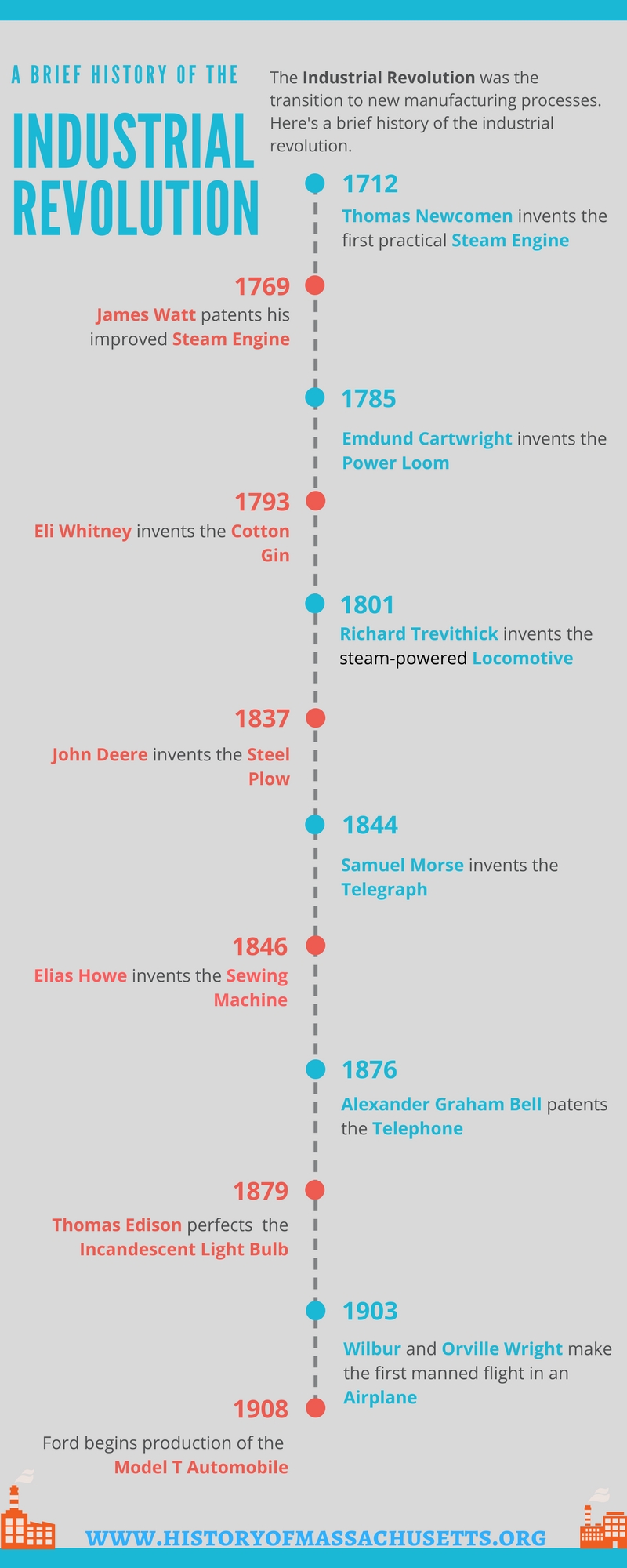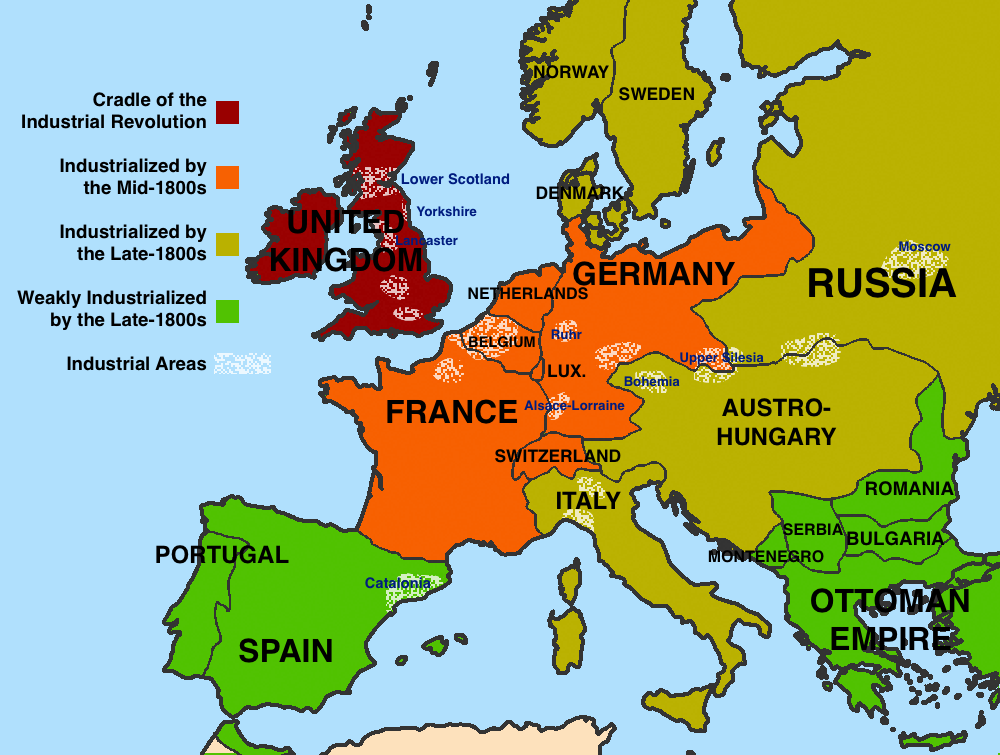A Spinning Jenny machine
 The Industrial Revolution was a time period between 1750-1830 where transformations and changes were made in various disciplines including:
The Industrial Revolution was a time period between 1750-1830 where transformations and changes were made in various disciplines including:
- Economics/Finance
- Manufacturing
- Transportation
- Technology
- Political Theory
- Sociology
- Warfare
- Art and Culture
Topics on the Page
Overview
Impact of Technology
Financial Impacts of Industrialization
- Vast increases in productivity and wealth
Population and urban growth
 Timeline link forthe industrial revolution. This website is great for elementary/middle school students
Timeline link forthe industrial revolution. This website is great for elementary/middle school students

Problems caused by urbanization and harsh working conditions
-
Women in the Industrial Revolution
- Industry and Slavery in the United States
Revolutionary Movements
American Immigrants and their Impacts on the Industrial Revolution
Focus Question:
What was the social and economic impact of the Industrial Revolution?
 U.S. History Cross-Links
U.S. History Cross-Links

.png) From Agricultural to the Industrial Revolution
From Agricultural to the Industrial Revolution
 Click here for John Green's "Crash Course History" about coal, steam, and the industrial revolution
Click here for John Green's "Crash Course History" about coal, steam, and the industrial revolution
Click here for a Prezi on why the industrial revolution occurred, what and who were involved, and its effects
 Primary sources and lesson plans on the Industrial Revolution in the United States from the Library of Congress click here.
Primary sources and lesson plans on the Industrial Revolution in the United States from the Library of Congress click here.
 |
| A map of Europe colored to show which countries industrialized at which time |
England was the first country to take part in the Industrial Revolution for several reasons.
1. The raw material Britain might have needed to start new inventions were easily accessible through their numerous colonies.
2. There were large coal deposits in England, which were used to process these raw materials.
3. The colonies also served as imperative markets to sell the new goods and services too, which essentially ensures that the products created will be purchased.
4. They were flexible and wiling to accept the theories of Adam Smith's "invisible hand" to a certain extent. They were open to 'new money' and family that were willing to take risks creating advancements.
5. The population was relatively well educated, which enabled a strong workforce to learn the new machinery and inventions.
For more information on Britain's development during the Industrial Revolution click here and explore the British Museum's exhibit.
Iron and Coal (1855-60) by William Bell Scott

 Impacts of Technology
Impacts of Technology
1. New technologies in agriculture improved the efficiency of farms, making an abundance of food. Populations increased dramatically.
2. New technologies like the steam engine improved resource extraction, factory production, and transportation of goods.
3. As these factories and farms sent out more products, the prices dropped, allowing for more people to purchase them.
4. Due to the Enclosure Movement, many peasants were forced to move to cities to find work.
5. As more factories opened, new work opportunities opened in the cities, causing more peasants to find work in the city.
6. The distribution of wealth shifted from the nobility and church to the masses, which allowed for the creation of the middle class.
7. Massive population increases in the cities led to crowded and unsanitary conditions.
8. Factory owners took advantage of low workers' rights and lowered wages for workers. Women and children were used for work, because they were cheaper to hire than men.
9. Opposition to the changes created by the Industrial Revolution by groups such as the Luddites emerged. These groups advocated for better working conditions and higher wages.
10. The world began to move to more globalized trade. Trains and faster ships decreased the time spent traveling from place to place.
For more information on how the inventions of the Industrial Revolution changed the our perceptions watch John Green's Crash Course on the impacts of railroads and the Industrial Revolution.
Frame-Breakers (or Luddites) Smashing a Loom, 1812

Luddites and the Luddite Rebellion of 1811-1813
The Luddites, 1811-1816 from Victorian Web
What the Luddites Really Fought Against, Richard Conniff, Smithsonian Magazine, March 2011
The Frame Breaking Act of 1812
For more information about politics, power struggles, and protests during the industrial revolution, click here
Financial Implications of the Industrial Revolution
There are numerous financial implications that enabled the Industrial Revolution to take place during this time.
1) Stable Environment:
A stable environment is crucial for development. The surrounding countries such as Spain, Portugal, Netherlands etc. had stable monarchies, which provided a safe environment for social, technological and cultural changes.
2) Capital Investment:
The United States, was a land filled with natural resources, specifically gold and silver. These natural resources doubled European wealth, which enabled the wealthy more flexibility to invest in further inventions.
3) Capitalism:
Adam Smith's 'invisible hand theory increase competition and the drive to create new products. He motivated Britain to explore their imaginations and try to accumulate more wealth by investing in the industry.
To learn more about the economic changes of the Industrial Revolution read this article by Professor Pat Hudson from the BBC.
The Vast Increases in Productivity and Wealth
- Productivity was increased in Europe during the Industrial Revolution largely based on the fact that new technology, such as Watt's Steam Engine, was able to speed up the production process. Not only could natural resources (such as coal) be extracted and shipped quickly, they could also be done so inexpensively. This allowed for more production and a huge amount of capital being brought to the owners of the mines.
- The same was true for factories, which were becoming increasingly important throughout the region. New textile machines were introduced into the industry; these machines created quick and cheap materials for the general public to purchase. Prior to the invention of these machines, textiles were usually produced in the home or were purchased for outrageously expensive prices. These textile factories also allowed people who previously had only worked in the agricultural realm to enter a more urban area and work for actual wages.
- These people became consumers themselves and added more wealth to society, and especially to the entrepreneurs of the era.
- Due to greater demand, greater amounts of lawyers, doctors, and other service workers gained more wealth and were a part of the new middle class.
See if you can be a successful entrepreneur during the Industrial Revolution in England with the game Who Wants to be a Cotton Millionaire from the BBC.

Population and Urban Growth
- As farming became more of an exact science during the Industrial Revolution through the use of new machinery and technology, European farmers were able to produce a surplus amount of food.
- This resulted in increased health and a population explosion.
- In 1695, the population of England was 5.5 million. By 1801, the population was 9.3 million, and the population skyrocketed again, to 15.9 million in 1841.
- Due to England's new laws of Enclosure, which basically reduced the number of farmers in rural areas of the land and displaced peasant farmers, a large population had to leave the agricultural realm and enter an urban area in pursuit of work.
- Since so many peasants were removed from the countryside, the factories were flooded with potential workers who were desperate for employment.
- While this helped the Industrial Revolution as an economic movement, it created social problems that England would have to deal with for decades.
 Click here to visit the Science and Industry Museum and learn about Manchester during the Industrial Revolution.
Click here to visit the Science and Industry Museum and learn about Manchester during the Industrial Revolution.
Click here for an interactive animation of Britain's population history. Take note of the massive population growth that took place between the 18th and 19th centuries as a result of the growth of cities.
Fleet Street 1842

Problems Caused by Urbanization and Harsh Working Conditions

- With a large influx of poor workers pouring into England's cities, poor working and living conditions were to be expected.
- Until the 1800s, there were no health laws in England for the poor, so most factory workers lived in filthy tenement buildings.
- Many of the buildings were made of cheap slate so they were cold and damp
- They often had to share water sources and waste facilities which caused disease to run rampant through the living areas. Death rates were high when people were subjected to such living conditions.
- 50% of Manchester in 1830 had no drainage system, contributing to the easy spread of disease
- Conditions at the factories were not much better; extremely long hours, poor pay, and disease made the factories miserable places to spend your working days.
Since they were paid less than men in factories, factory owners made a practice of hiring women and children in order to keep costs down and increase their own profits.
- Young children and women were paid two dollars a week and worked from 5 am to 7 pm, with one half hour break for breakfast and one for dinner.
- The social repercussions of women working were always worried about. Society worried that working would taint them and make them less suitable for marriage.
- Due to the concentration of women in the workforce during the Industrial Revolution, early forms of feminism began to emerge from women factory workers.
- This spawned more female involvement in many reform movements, including anti-slavery movements and ones against the Mexican American War.
- In Lowell, Massachusetts, for example, female factory workers started their own publication called The Lowell Offering.
- Explore a digital version of The Lowell Offering from Harvard's digital library service.
- Until 1833 when the Factory Acts were passed, there were no limits on child labor in England, mostly due to the pressure factory owners placed on the government.
Slavery had continued in the United States, where it was allowed for slaves to work in factories. Many industries in the southern US had slaves working as free labor in factories and craft industries.
Child Labor
 Attached below are some primary source documents that deal with child labor, especially as it pertains to Great Britain in the 1830s. A number of these sources are directly related to the Sadler Commission and what it was like to live in early industrial England.
Attached below are some primary source documents that deal with child labor, especially as it pertains to Great Britain in the 1830s. A number of these sources are directly related to the Sadler Commission and what it was like to live in early industrial England.
Child labor.doc
child labor interviews.doc
Description of Manchester.docx
speech on labor reform.doc
Child testimony.pdf
https://www.youtube.com/watch?v=zF_U4VGl1Jk&ab_channel=jamie932
A Comedic view on the dark reality of children in the industrial revolution workplace.
- The use of child labor has been practiced far back into human history.
- The Industrial Revolution represented a skyrocketing of the number of child workers as they went to work in factories to help support their families.
- Starting in London and neighboring British cities, factories popped up across Europe and over to America
- Factory owners saw children as valuable assets to their production
- small stature of children and their ability to fit in small spaces
- the small size of their hands able to make delicate items
- able to be paid lower wages
- more difficult for children to unionize
- Especially in the early years, factories and their policies were unregulated and their workers were unprotected
- In these factories, children were exposed to such dangerous conditions, they often died or were seriously injured
- They were promised a bed and food
- These children were often orphans
- Some workhouses offered education, but usually they were vocational skills masked with the title of education
- They were signed over to work as apprentices until the age of 21
- If they tried escaping, in some instances, they were sent to horrid "punishment rooms" is solitary confinement for a week
- Watch this video by BBC on child labor at the wake of the revolution as well as its parallels to today's instances of child labor
Women in the Industrial Revolution
Women in the industrial revolution were used as cheap labor, just as children were. Many women worked in the textile industry, making clothing.
Many women chose factory work over marriage and staying at home. At a time of great social upheaval, women were able to work independently of men.
Factory owners liked to hire women because they could pay them less. At the time, women were paid about half of a man's wage.
Charlotte Bronte was an English poet and writer, active between the 1820s and 1850s. Her book, Shirley, A Tale examines the culture in England in the industrial depression after the Napoleonic Wars and War of 1812. The novel is set during the Luddite Uprisings in Yorkshire. Click here to learn more about Bronte and her work as a poet and writer.
For primary sources about women's working conditions, see The Plight of Women's Work in the Early Industrial Revolution in England and Wales

Click here for a Prezi on the role of women in society during the Industrial Revolution
Click here for more information on life in industrial towns
Click here for a short video explaining the effects of Industrialization in Great Britain.
Industry and Slavery in the United States
England was only the first of many countries to begin industrialization in the early 1800s. In the southern United States, slavery was used as free labor in factories.
In the pottery industry, slaves like Dave the Potter wrote inscriptions and poems on their artwork, at a time when reading and writing for slaves was a crime.
This link is to a 60 minute lecture from The University if the District of Colombia and focuses on slavery and the Industrial Revolution. https://www.youtube.com/watch?v=rb3hzhyBucw
This link is to a BBC piece on slavery and how the industrial revolution increased the desire for slaves.
https://www.bbc.co.uk/bitesize/guides/zc92xnb/revision/4#:~:text=Slavery%20provided%20the%20raw%20material,change%20in%20modern%20economic%20history.
Revolutionary Movements
Karl Marx, 1861

Communism
Karl Marx wrote in The Communist Manifesto (1848) that all of human history is based on the conflict between the bourgeoisie (those who own the means of production) and the proletariat (working class). He predicted that the proletariat would rise up in a violent revolution to overthrow the bourgeoisie and create a society with an equal distribution of goods and services.
Click here for more information on the beginnings of Communism
This link contains a detailed description of the life and ideas of Karl Marx
This video describes the political theory of Communism as it was viewed by Karl Marx
Co-operative Movement
This website provides information on the Co-operative Movement that emerged during the Industrial Revolution as an alternative to Capitalism
This video describes the history behind the Co-operative movement that emerged in England during the Industrial Revolution
History of the Co-Operative Movement from the International Cooperative Alliance
American Immigrants and their Impact on the Industrial Revolution
-
America's story is one of immigrants. The Industrial Revolution was happening simultaneously with the influx of American immigration. Immigrants of all ages came to America to work in factories for low wages in poor conditions. The Triangle Shirtwaist Factory was no exception.
- The fire at the Triangle Shirtwaist Factory was a tragic event that took 146 lives of mostly immigrant women. Tragedies were common among immigrants and largely forgotten.
- The Hollingworth Letters are a collection of letters from British-American immigrants in the early 19th century writing to loved ones in England about their experiences. Click here to read the letters
 Large scale immigration to the United States during the 1800's
Large scale immigration to the United States during the 1800's
Works Cited
Child Labour and the Industrial Revolution. Retrieved March 1, 2007, from Nettlesworth School Web site: http://www.nettlesworth.durham.sch.uk/time/victorian/vindust.html
Photograph of Hand Loom. Retrieved March 1, 2007, from Social Studies School Service Web site: http://www.socialstudies.com/c/@8-GiQs9KLJk_E/Pages/worldlinks.html
Industrial Revolution History. Retrieved March 5, 2009, from website:
http://regentsprep.org/Regents/global/themes/change/ind.cfm
Art History:
http://smarthistory.khanacademy.org/
Comments (0)
You don't have permission to comment on this page.